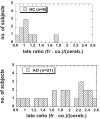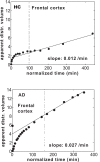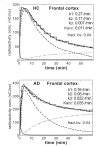Unidirectional Influx and Net Accumulation of PIB
- PMID: 19526073
- PMCID: PMC2695622
- DOI: 10.2174/1874440000802010114
Unidirectional Influx and Net Accumulation of PIB
Abstract
The compound {N-methyl-[(11)C]}2-(4'-methylaminophenyl)-6-hydroxybenzothiazole, "PIB", measured by positron emission tomography, has been demonstrated to image brain beta-amyloid deposition in Alzheimer's disease (AD). In the present study the benefit of measuring the PIB accumulation rate together with the unidirectional influx of PIB into the brain was investigated in healthy control subjects and patients with AD. In a monkey changes in the influx rate constant K(1) of PIB closely followed changes in CBF, caused by alteration of Pa(CO2). In addition, K(1) was high both in the monkey and in humans, suggesting that this parameter reflects CBF. Most AD patients studied showed clearly higher accumulation rate for PIB than the controls in cortical brain areas, while a few patients showed as low accumulation as the controls. K(1) did not correlate with the accumulation rate, indicating that K(1) for PIB provides extra information besides the accumulation rate.
Keywords: Alzheimer´s disease; PET.; beta amyloid; cerebral blood flow; kinetic modeling.
Figures





Similar articles
-
The use of PIB-PET as a dual pathological and functional biomarker in AD.Biochim Biophys Acta. 2012 Mar;1822(3):380-5. doi: 10.1016/j.bbadis.2011.11.006. Epub 2011 Nov 13. Biochim Biophys Acta. 2012. PMID: 22115832
-
Two-year follow-up of amyloid deposition in patients with Alzheimer's disease.Brain. 2006 Nov;129(Pt 11):2856-66. doi: 10.1093/brain/awl178. Epub 2006 Jul 19. Brain. 2006. PMID: 16854944
-
Relative 11C-PiB Delivery as a Proxy of Relative CBF: Quantitative Evaluation Using Single-Session 15O-Water and 11C-PiB PET.J Nucl Med. 2015 Aug;56(8):1199-205. doi: 10.2967/jnumed.114.152405. Epub 2015 Jun 4. J Nucl Med. 2015. PMID: 26045309 Free PMC article.
-
Cerebral Blood Flow and Aβ-Amyloid Estimates by WARM Analysis of [11C]PiB Uptake Distinguish among and between Neurodegenerative Disorders and Aging.Front Aging Neurosci. 2017 Jan 11;8:321. doi: 10.3389/fnagi.2016.00321. eCollection 2016. Front Aging Neurosci. 2017. PMID: 28123366 Free PMC article.
-
PET amyloid ligand [11C]PIB uptake is increased in mild cognitive impairment.Neurology. 2007 May 8;68(19):1603-6. doi: 10.1212/01.wnl.0000260969.94695.56. Neurology. 2007. PMID: 17485647
Cited by
-
Dynamic Amyloid PET: Relationships to 18F-Flortaucipir Tau PET Measures.J Nucl Med. 2022 Feb;63(2):287-293. doi: 10.2967/jnumed.120.254490. Epub 2021 May 28. J Nucl Med. 2022. PMID: 34049986 Free PMC article.
-
Multi-graphical analysis of dynamic PET.Neuroimage. 2010 Feb 15;49(4):2947-57. doi: 10.1016/j.neuroimage.2009.11.028. Epub 2009 Nov 17. Neuroimage. 2010. PMID: 19931403 Free PMC article.
-
Analysis of early phase [11C]BF-227 PET, and its application for anatomical standardization of late-phase images for 3D-SSP analysis.Jpn J Radiol. 2014 Mar;32(3):138-44. doi: 10.1007/s11604-013-0276-7. Epub 2014 Jan 10. Jpn J Radiol. 2014. PMID: 24408078
-
Identifying Mild Alzheimer's Disease With First 30-Min 11C-PiB PET Scan.Front Aging Neurosci. 2022 Apr 5;14:785495. doi: 10.3389/fnagi.2022.785495. eCollection 2022. Front Aging Neurosci. 2022. PMID: 35450057 Free PMC article.
-
Quantification of 11C-PIB kinetics in cardiac amyloidosis.J Nucl Cardiol. 2020 Jun;27(3):774-784. doi: 10.1007/s12350-018-1349-x. Epub 2018 Jul 23. J Nucl Cardiol. 2020. PMID: 30039218 Free PMC article.
References
-
- Braak H, Braak E. Neuropathological stageing of Alzheimer-related changes. Acta Neuropathol (Berl) 1991;82:239–59. - PubMed
-
- Mirra SS, Heyman A, McKeel D, et al. The consortium to establish a registry for Alzheimer's disease (CERAD). Part II. Standardization of the neuropathologic assessment of Alzheimer’s disease. Neurology. 1991;41:479–86. - PubMed
-
- Klunk W, Engler H, Nordberg A, et al. Imaging Brain Amyloid in Alzheimer's disease with Pittsburgh Compound-B. Ann Neurol. 2004;55:306–19. - PubMed
-
- Price J, Klunk WE, Lopresti BJ, et al. Kinetic modelling of amyloid binding in humans using PET imaging and Pittsburgh compound-B Quantitative PIB. J Cereb Blood Flow Metab. 2005;25:1528–47. - PubMed
-
- Lopresti BJ, Klunk WE, Mathis CA, et al. Simplified quantification of Pittsburg compound B amyloid imaging studies: a comparative analysis. J Nucl Med. 2005;46:1959–72. - PubMed
LinkOut - more resources
Full Text Sources
